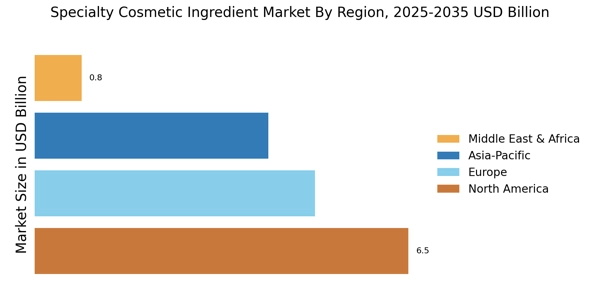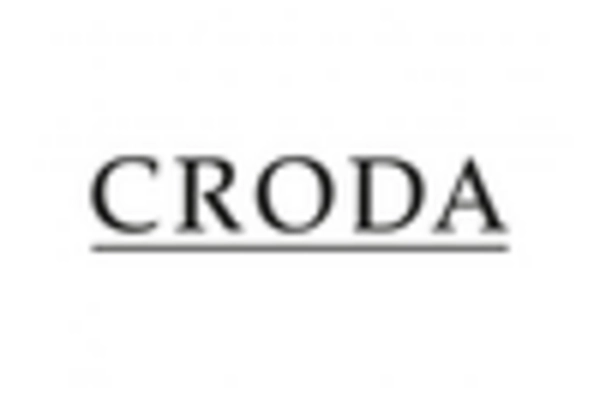Rising Popularity of Anti-Aging Products
The Specialty Cosmetic Ingredient Market is significantly influenced by the rising popularity of anti-aging products. As the global population ages, there is an increasing demand for products that address signs of aging, such as wrinkles and loss of elasticity. This trend has led to a surge in the incorporation of specialty ingredients known for their anti-aging properties, such as peptides, antioxidants, and hyaluronic acid. Market analysis indicates that the anti-aging segment is expected to grow at a rate of around 9% per year, reflecting consumers' willingness to invest in products that promise youthful skin. Consequently, manufacturers are focusing on developing innovative formulations that leverage these specialty ingredients, thereby enhancing their market presence and catering to the evolving preferences of consumers.
Focus on Sustainable and Ethical Sourcing
Sustainability and ethical sourcing have emerged as critical drivers in the Specialty Cosmetic Ingredient Market. Consumers are increasingly concerned about the environmental impact of their purchases, leading to a demand for ingredients that are sustainably sourced and produced. This trend is reflected in the growing popularity of brands that prioritize ethical practices, such as fair trade and eco-friendly sourcing. Market data suggests that products marketed as sustainable are likely to see a growth rate of around 12% in the coming years. As a result, manufacturers are compelled to adopt sustainable practices in their ingredient sourcing and production processes. This focus not only meets consumer expectations but also enhances brand loyalty, as consumers are more inclined to support companies that align with their values regarding sustainability and ethical responsibility.
Growth of E-commerce in the Beauty Sector
The Specialty Cosmetic Ingredient Market is experiencing a transformation due to the rapid growth of e-commerce platforms. The convenience of online shopping has made it easier for consumers to access a wide range of beauty products, including those featuring specialty ingredients. E-commerce sales in the beauty sector have seen a remarkable increase, with projections indicating a growth rate of over 15% annually. This shift not only expands the reach of brands but also allows for greater consumer education regarding the benefits of specialty ingredients. As online platforms increasingly feature detailed product information and customer reviews, consumers are more informed and likely to make purchases based on ingredient efficacy. This trend is expected to continue, further driving the demand for specialty cosmetic ingredients as brands adapt their marketing strategies to leverage the e-commerce boom.
Increasing Demand for Clean Beauty Products
The Specialty Cosmetic Ingredient Market is witnessing a notable shift towards clean beauty products, driven by consumer awareness regarding ingredient safety and environmental sustainability. As consumers become more discerning, they increasingly seek products free from harmful chemicals, which has led to a surge in demand for natural and organic ingredients. According to recent data, the clean beauty segment is projected to grow at a compound annual growth rate of over 10% in the coming years. This trend compels manufacturers to innovate and reformulate their products, thereby creating opportunities for specialty cosmetic ingredients that align with these clean beauty standards. The emphasis on transparency in ingredient sourcing and formulation further propels this market driver, as consumers demand more information about the products they use on their skin.
Technological Advancements in Ingredient Development
Technological advancements play a pivotal role in shaping the Specialty Cosmetic Ingredient Market. Innovations in extraction and formulation techniques have enabled the development of high-performance ingredients that cater to diverse consumer needs. For instance, advancements in biotechnology have led to the creation of bioactive compounds that enhance skin health and appearance. The market for such innovative ingredients is expected to expand, with estimates suggesting a growth rate of approximately 8% annually. Furthermore, the integration of artificial intelligence in product formulation allows for more personalized and effective cosmetic solutions. As brands increasingly adopt these technologies, the demand for specialty ingredients that can deliver unique benefits is likely to rise, thereby driving the overall market forward.


















Leave a Comment